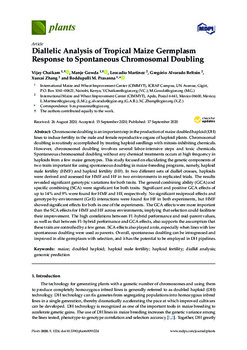Mostrar el registro sencillo del ítem
Diallelic analysis of tropical maize germplasm response to spontaneous chromosomal doubling
| Autor: | Chaikam, V. |
| Autor: | Gowda, M. |
| Autor: | Martinez, L. |
| Autor: | Alvarado Beltrán, G. |
| Autor: | Xuecai Zhang |
| Autor: | Prasanna, B.M. |
| Año: | 2020 |
| ISSN: | 2223-7747 (Online) |
| URI: | https://hdl.handle.net/10883/20958 |
| Formato: | |
| Lenguaje: | English |
| Editor: | MDPI |
| Copyright: | CIMMYT manages Intellectual Assets as International Public Goods. The user is free to download, print, store and share this work. In case you want to translate or create any other derivative work and share or distribute such translation/derivative work, please contact CIMMYT-Knowledge-Center@cgiar.org indicating the work you want to use and the kind of use you intend; CIMMYT will contact you with the suitable license for that purpose. |
| Tipo: | Article |
| Lugar de publicación: | Basel (Switzerland) |
| Número: | 9 |
| Volumen: | 9 |
| DOI: | 10.3390/plants9091224 |
| Palabras Claves: | Doubled Haploid |
| Palabras Claves: | Haploid Male Fertility (HMF) |
| Palabras Claves: | Haploid Fertility (HF) |
| Palabras Claves: | Genomic Prediction |
| Descripción: | Chromosome doubling is an important step in the production of maize doubled haploid (DH) lines to induce fertility in the male and female reproductive organs of haploid plants. Chromosomal doubling is routinely accomplished by treating haploid seedlings with mitosis-inhibiting chemicals. However, chromosomal doubling involves several labor-intensive steps and toxic chemicals. Spontaneous chromosomal doubling without any chemical treatments occurs at high frequency in haploids from a few maize genotypes. This study focused on elucidating the genetic components of two traits important for using spontaneous doubling in maize-breeding programs, namely, haploid male fertility (HMF) and haploid fertility (HF). In two different sets of diallel crosses, haploids were derived and assessed for HMF and HF in two environments in replicated trials. The results revealed significant genotypic variations for both traits. The general combining ability (GCA) and specific combining (SCA) were significant for both traits. Significant and positive GCA effects of up to 14% and 9% were found for HMF and HF, respectively. No significant reciprocal effects and genotype-by-environment (G×E) interactions were found for HF in both experiments, but HMF showed significant effects for both in one of the experiments. The GCA effects were more important than the SCA effects for HMF and HF across environments, implying that selection could facilitate their improvement. The high correlations between F1-hybrid performance and mid-parent values, as well as that between F1-hybrid performance and GCA effects, also supports the assumption that these traits are controlled by a few genes. SCA effects also played a role, especially when lines with low spontaneous doubling were used as parents. Overall, spontaneous doubling can be introgressed and improved in elite germplasm with selection, and it has the potential to be employed in DH pipelines. |
| Agrovoc: | MAIZE |
| Agrovoc: | HAPLOIDY |
| Agrovoc: | FERTILITY |
| Agrovoc: | DIALLEL ANALYSIS |
| Agrovoc: | GENOMICS |
| Revista: | Plants |
| Número de artículo: | 1224 |
Ficheros en el ítem
Este ítem aparece en la(s) siguiente(s) colección(ones)
-
Maize
Maize breeding, phytopathology, entomology, physiology, quality, and biotech

